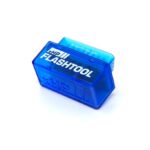Navigating car diagnostics can be daunting, especially when faced with a check engine light. For owners of a Hyundai Elantra 2006 model, understanding the OBDII system is the first step towards efficient vehicle maintenance and repair. This guide will pinpoint the OBDII port location in your 2006 Hyundai Elantra and discuss how to utilize this port for diagnosing common issues.
Locating the OBDII Port in Your 2006 Hyundai Elantra
Finding the OBDII port in your Hyundai Elantra 2006 is straightforward. You don’t need to be an expert mechanic to locate it. The OBDII connector is situated directly beneath the lower-left side of the dashboard, under the steering column. Specifically, it’s a few inches to the right of the hood release lever. You’ll find it conveniently attached to the underside of the panel, angled downwards. This positioning is designed for easy access when you need to connect a scanner.
Alt: OBDII port location in a 2006 Hyundai Elantra, positioned under the dashboard near the steering column for diagnostic access.
Decoding Check Engine Lights and OBD-II Diagnostics
The On-Board Diagnostics II (OBD-II) system is a standardized system in modern vehicles that monitors various components for optimal performance and emissions control. When your 2006 Hyundai Elantra‘s check engine light illuminates, it signals that the vehicle’s computer has detected an issue. The OBDII port is your gateway to understanding these issues. By connecting an OBDII scanner to this port, you can retrieve diagnostic trouble codes (DTCs) that pinpoint potential problems.
Addressing the P0172 Code: Fuel System Rich in a 2006 Elantra
A common concern for Hyundai Elantra 2006 owners is the check engine light accompanied by a P0172 code, indicating a “Fuel System Rich” condition. This code suggests that the engine is receiving too much fuel compared to air. This can stem from various factors, and understanding the context of when the light appears can be helpful.
For instance, experiencing this issue after driving in hot weather, turning off the car, and then restarting after a short period might point towards evaporative emission system issues. One potential culprit in such scenarios is the Purge Control Solenoid Valve (PCSV). A malfunctioning PCSV can prevent proper venting of fuel vapors, leading to a rich fuel mixture and triggering the P0172 code.
Alt: Purge Control Solenoid Valve (PCSV) component, a potential cause for P0172 error code in Hyundai Elantra emission system.
While dealerships follow diagnostic procedures, sometimes intermittent issues like a sticking PCSV can be challenging to pinpoint during standard tests. If the problem recurs, especially under similar conditions, considering the evaporative emission system and components like the PCSV is a logical step.
Investing in an OBDII Scan Tool for Your Hyundai Elantra
For proactive maintenance and quicker diagnostics, especially for recurring issues, investing in an OBDII scan tool can be a valuable decision for a Hyundai Elantra 2006 owner. Tools like the Equus Innova 3130 (now branded as Innova) are popular choices for DIY enthusiasts and offer user-friendly interfaces for reading and clearing codes.
Having your own OBDII scanner eliminates the need for frequent trips to the mechanic just to read a code. It empowers you to:
- Quickly identify the cause of a check engine light.
- Monitor your vehicle’s health.
- Potentially save on diagnostic fees.
- Make informed decisions about repairs.
While a scan tool is not a replacement for professional diagnostics and repair, it’s an excellent first step in understanding your Hyundai Elantra 2006‘s health and addressing minor issues promptly. For complex problems or persistent codes, consulting a certified mechanic remains crucial.
In conclusion, knowing the OBDII port location in your Hyundai Elantra 2006 and understanding how to use an OBDII scanner are valuable skills for any car owner. This knowledge, combined with understanding common issues like the P0172 code and potential causes like a faulty PCSV, can contribute to better vehicle maintenance and a more informed approach to automotive care.


